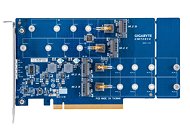Thursday, March 15th 2018

GIGABYTE Intros CMT2014 M.2 Slot Card
GIGABYTE today rolled out the CMT2014, an add-on card that converts a PCI-Express gen 3.0 x16 slot into four 32 Gbps M.2 PCIe slots, using PCIe lane-segmentation on the motherboard's end (it doesn't have any bridge chip on its end). This is similar in function, concept, and design to the ASRock Ultra Quad M.2, and the ASUS Hyper M.2, but lacks any mechanism to cool the drives. You get four M.2-22110 slots with PCI-Express gen 3.0 x4 wiring, two of these slots face forwards, and the others backwards.
If you have M.2-2280 (or smaller) drives installed on the slots that face backwards, you can physically (and irreversibly) break off a piece of the card to reduce its length from 21 cm to around 18.5 cm. Other features include power/activity LEDs for each of the four slots, and temperature sensors positioned where most SSDs have their controllers located. The company didn't reveal pricing, but to prevent RMAs from people who can't get it to work on their motherboards lacking lane segmentation, it mentioned that the card is only intended for Xeon "Purley" platform, for now.
If you have M.2-2280 (or smaller) drives installed on the slots that face backwards, you can physically (and irreversibly) break off a piece of the card to reduce its length from 21 cm to around 18.5 cm. Other features include power/activity LEDs for each of the four slots, and temperature sensors positioned where most SSDs have their controllers located. The company didn't reveal pricing, but to prevent RMAs from people who can't get it to work on their motherboards lacking lane segmentation, it mentioned that the card is only intended for Xeon "Purley" platform, for now.


4 Comments on GIGABYTE Intros CMT2014 M.2 Slot Card
Maybe not quite as bad as Asus' design, but ASRock clearly wins this one in terms of best PCB layout.
In general, I like this solution better than mobo mounted M2 slots scattered and hidden under other cards.
(Useless interfaces are increasing on mobos (exceptions exist): to many PCI-E slots, HyperM2, M2...) In the past I had only PCI-E and they were all filled.